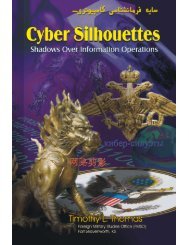Uyghurs Without Borders? - Foreign Military Studies Office - U.S. Army
Uyghurs Without Borders? - Foreign Military Studies Office - U.S. Army
Uyghurs Without Borders? - Foreign Military Studies Office - U.S. Army
You also want an ePaper? Increase the reach of your titles
YUMPU automatically turns print PDFs into web optimized ePapers that Google loves.
groups, but that it does not include all aspects of Uyghur interests, especially in Kazakhstan.This leads to the third reason; that <strong>Uyghurs</strong> in Kazakhstan have a high enough economic andsocial status that they are integrated to a point where their loyalty and view towards their kin inXinjiang may not be in line with other Uyghur interest groups. If another incident like the July2009 Riots occurs, this group’s status can determine their level of support for violent elements inXinjiang. Their status and integration levels can also be an indicator of how likely they are to beinvolved in interethnic clashes if a Kyrgyzstan type situation, where interethnic violence betweenUzbeks and Kyrgyz occurred in June 2010, were to happen in Kazakhstan. Ultimately, thisgroup of <strong>Uyghurs</strong> could be looked at as an integration model for ethnic minorities in CentralAsia.BackgroundBefore examining <strong>Uyghurs</strong>’ status and integration in Kazakhstan, it is necessary to givesome historical background on this ethnic group, particularly how they came to be inKazakhstan. <strong>Uyghurs</strong> are Turkic people, originating in the Eurasian Steppe region. Theirhistory stretches back to 744, when they formed their own khanate in the Orkhon Valley, presentday Mongolia. 4The history of <strong>Uyghurs</strong> is well documented after the formation of this khanate,but the focus of this article is what historical events have most influenced <strong>Uyghurs</strong> inKazakhstan, which is in more recent history. These events start with the Russian Empire’sexpansion in the Central Asian region; eastward into Siberia during the sixteenth througheighteenth centuries, and south into Central Asia during the Great Game. 5This expansionhappened in areas to the west and north of Xinjiang, the region that modern <strong>Uyghurs</strong> view astheir homeland.3
















